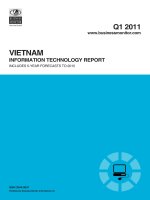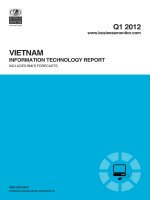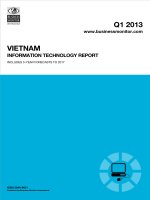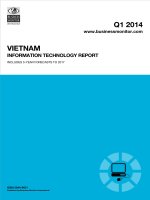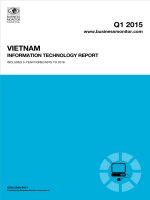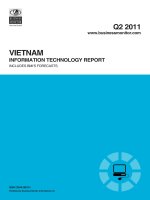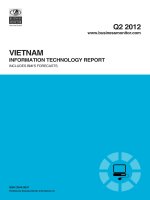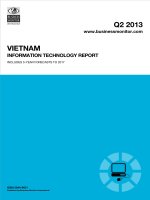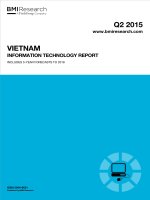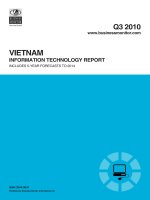Vietnam information technology report q2 2013
Bạn đang xem bản rút gọn của tài liệu. Xem và tải ngay bản đầy đủ của tài liệu tại đây (414.78 KB, 73 trang )
Q2 2013
www.businessmonitor.com
VIETNAM
INFORMATION TECHNOLOGY REPORT
INCLUDES 5-YEAR FORECASTS TO 2017
ISSN 2044-9631
Published by:Business Monitor International
Vietnam Information Technology
Report Q2 2013
INCLUDES 5-YEAR FORECASTS TO 2017
Part of BMI’s Industry Report & Forecasts Series
Published by: Business Monitor International
Copy deadline: April 2013
Business Monitor International
Senator House
85 Queen Victoria Street
London
EC4V 4AB
United Kingdom
Tel: +44 (0) 20 7248 0468
Fax: +44 (0) 20 7248 0467
Email:
Web:
© 2013 Business Monitor International
All rights reserved.
All information contained in this publication is
copyrighted in the name of Business Monitor
International, and as such no part of this
publication may be reproduced, repackaged,
redistributed, resold in whole or in any part, or used
in any form or by any means graphic, electronic or
mechanical, including photocopying, recording,
taping, or by information storage or retrieval, or by
any other means, without the express written consent
of the publisher.
DISCLAIMER
All information contained in this publication has been researched and compiled from sources believed to be accurate and reliable at the time of
publishing. However, in view of the natural scope for human and/or mechanical error, either at source or during production, Business Monitor
International accepts no liability whatsoever for any loss or damage resulting from errors, inaccuracies or omissions affecting any part of the
publication. All information is provided without warranty, and Business Monitor International makes no representation of warranty of any kind as
to the accuracy or completeness of any information hereto contained.
CONTENTS
BMI Industry View 7
SWOT 9
IT SWOT 9
Political 11
Economic 12
Business Environment 13
Industry Forecast 14
Table: Vietnam IT Industry - Historical Data And Forecasts (VNDbn) 14
Macroeconomic Forecasts 19
Economic Analysis - Q2 2013 19
Inflation Still A Manageable Risk 20
Expenditure Breakdown 21
Table: Vietnam - Economic Activity 22
Industry Risk Reward Ratings 23
Industry Risk/Reward Ratings 23
Table: Asia Pacific IT Risk/Reward Ratings - Q2 2013 26
Market Overview 27
Vietnam 27
Hardware 27
Software 32
Services 41
Industry Trends And Developments 47
Regulatory Development 50
Table: Government Authority 50
Regulatory News 52
Company Profile 54
FPT Software 54
Regional Overview 57
Asia Pacific Regional Market Overview 57
IT Penetration 57
IT Growth and Drivers 59
Sectors And Verticals 61
Demographic Forecast 65
Vietnam Information Technology Report Q2 2013
© Business Monitor International Page 4
Table: Vietnam's Population By Age Group, 1990-2020 ('000) 66
Table: Vietnam's Population By Age Group, 1990-2020 (% of total) 67
Table: Vietnam's Key Population Ratios, 1990-2020 68
Table: Vietnam's Rural And Urban Population, 1990-2020 68
Methodology 69
Methodology 69
IT Industry 69
IT Ratings - Methodology 70
Table: IT Business Environment Indicators 71
Weighting 72
Table: Weighting Of Components 72
Sources 72
Vietnam Information Technology Report Q2 2013
© Business Monitor International Page 5
BMI Industry View
BMI View: Vietnamese IT spending is expected to reach VND62,604bn (US$3.01bn) in 2013, up 18.6%
from 2012. The macroeconomic environment is supportive of faster growth, boosting trends within the IT
sector. Rising PC penetration, a range of government ICT initiatives and a campaign to develop Vietnam's
domestic IT industry will help to sustain expansion. Meanwhile, there is strong demand for ERP solutions
and cloud computing revenues are expected to report at least 300% growth over the five-year forecast
period to 2017. The outsourcing market is also expected to expand rapidly over the medium term as
enterprises, particularly in Japan, switch business away from China in search of cost savings.
Headline Expenditure Projections:
Computer Hardware Sales: VND38,261bn in 2012 to VND44,762bn in 2013, +17% in local currency
terms. Influx of cheap tablets from Windows 8 tablets and notebooks are expected to provide a growth area
in 2012.
Software Sales: VND4,630bn in 2012 to VND5,658nn in 2013, +22.2% in local currency terms. Potential
for strong growth in licensed operating systems and business software, but will depend on the success in
bringing down illegal software use.
IT Services Sales: VND9,882bn in 2012 to VND12,185bn in 2013, +23.3% in local currency terms.
Growing demand for digital infrastructure projects in various sectors, such as banking, telecoms, energy and
government - as well as a potential boom in outsourcing from Japanese enterprises to drive outperformance
of services segment.
Risk/Reward Ratings: Vietnam scores 34.2 out of 100 in our Asia Risk/Reward Ratings table. This places
the country 11th, ahead of Sri Lanka. The country ranks only 11th for its industry rewards score, with 38.1.
Key Trends & Developments.
There have been several reports in early 2013 of lower-price Chinese tablets as Hipad, Ondan, Teclast and
Ampe, entering the Vietnamese retail market. These products are undercutting traditional notebooks on
price, even after local dealers benefitting from high mark-ups. The margins available mean they are being
heavily promoted by local retailers. This has reportedly resulted in declines in prices for notebooks, which
are nevertheless finding themselves unable to compete at the low end of the market.
Vietnam Information Technology Report Q2 2013
© Business Monitor International Page 7
The outsourcing market in Vietnam is forecast for expansion from 2013. There has been increasing interest
in it as a business process and software developments outsourcing location, particularly from Japanese
enterprises. Vietnam has a cost advantage over China, which accounts for the majority of Japanese
outsourcing by value. This could see significant shifts as the trend gains momentum.
Vendors have reported continued robust sales of ERP solutions, despite the uncertain economic situation.
There is still a lot of potential for Vietnamese enterprises to increase spending on basic solutions. A number
of Vietnamese companies embarked on large-scale ERP implementations, including Hoang Anh Gia Lai
Group (HAGL), which launched a VND100bn ERP system. However, while the ERP market is strong, it is
estimated that only about 10% of Vietnamese businesses have used CRM.
The ambitious government IT plan for 2010-2020 will be a backdrop to all these developments in the
Vietnamese IT market, with the government pledging to invest VND2.4tn (US4,115mn) from the State
Budget in the ICT sector over this period. Meanwhile a number of government ministries and organisations,
including the Ministry of Education and Training, have started to promote the rollout of cloud
services. Many of the government's ICT development plans and programmes are still in a nascent stage and
their ultimate effectiveness is yet to be determined.
Vietnam Information Technology Report Q2 2013
© Business Monitor International Page 8
SWOT
IT SWOT
SWOT Analysis
Strengths
■
Government policies to expand ICT infrastructure and internet penetration are driving
demand for IT products and services.
■
Vietnam's gradual integration into the global trade network via its accession into trade
organisations such as ASEAN and WTO, as well as bilateral agreements with Japan
and China.
■
The domestic IT market is in a rapid growth phase, with trade liberalisation and
growing affordability driving projected double-digit growth of notebook computers.
Weaknesses
■
IT spend per capita much lower than in neighbouring Thailand, reflecting a much
lower GDP and GDP per capita.
■
Low levels of access to credit and budgets restrain spending by SMEs.
■
Highly cost-sensitive market, with 75% of software provided by lower-cost local
software vendors.
■
High level of software piracy, although progress has been made in recent years.
Opportunities
■
Vietnam is becoming a popular destination for outsourcing, with particularly strong
growth potential from Japanese enterprises.
■
High PC market growth potential particular in rural areas.
■
National IT Plan will drive spending on IT utilisation in areas such as e-government, e-
taxation and education.
■
SMEs have much potential to increase spending on basic solutions, including
customer relationship management and security.
■
Government spending on open source software creates opportunities for local IT
services firms to implement projects.
Vietnam Information Technology Report Q2 2013
© Business Monitor International Page 9
SWOT Analysis - Continued
■
Banking and finance, oil and gas, aviation and telecoms are projected to be some of
the biggest opportunities for multinational vendors.
■
The government's drive to create a significant IT services industry over the next 15-20
years is expected to be a significant factor shaping the IT market through incentives
to create IT clusters.
Threats
■
The implementation of the China-ASEAN free trade agreement means that
established multinationals will face a growing challenge from low-cost Chinese
vendors in the Vietnamese market.
■
Low cost tablets from own-brand Chinese vendors a particular threat to low- and
mid-range notebook vendors.
■
Falling prices may further undermine margins and profitability after steep discounting.
Vietnam Information Technology Report Q2 2013
© Business Monitor International Page 10
Political
SWOT Analysis
Strengths
■
The Communist Party of Vietnam remains committed to market-oriented reforms and
we do not expect major shifts in policy direction over the next five years. The one-
party system is generally conducive to short-term political stability.
■
Relations with the US have witnessed a marked improvement, and Washington sees
Hanoi as a potential geopolitical ally in South East Asia.
Weaknesses
■
Corruption among government officials poses a major threat to the legitimacy of the
ruling Communist Party.
■
There is increasing (albeit still limited) public dissatisfaction with the leadership's tight
control over political dissent.
Opportunities
■
The government recognises the threat corruption poses to its legitimacy, and has
acted to clamp down on graft among party officials.
■
Vietnam has allowed legislators to become more vocal in criticising government
policies. This is opening up opportunities for more checks and balances within the
one-party system.
Threats
■
Macroeconomic instabilities in 2012 are likely to weigh on public acceptance of the
one-party system, and street demonstrations to protest economic conditions could
develop into a full-on challenge of undemocractic rule.
■
Although strong domestic control will ensure little change to Vietnam's political scene
in the next few years, over the longer term, the one-party-state will probably be
unsustainable.
■
Relations with China have deteriorated over recent years due to Beijing's more
assertive stance over disputed islands in the South China Sea and domestic criticism
of a large Chinese investment into a bauxite mining project in the central highlands,
which could potentially cause wide-scale environmental damage.
Vietnam Information Technology Report Q2 2013
© Business Monitor International Page 11
Economic
SWOT Analysis
Strengths
■
Vietnam has been one of the fastest-growing economies in Asia in recent years, with
GDP growth averaging 7.1% annually between 2000 and 2012.
■
The economic boom has lifted many Vietnamese out of poverty, with the official
poverty rate in the country falling from 58% in 1993 to 14.0% in 2010.
Weaknesses
■
Vietnam still suffers from substantial trade, current account and fiscal deficits, leaving
the economy vulnerable to global economic uncertainties in 2012. The fiscal deficit is
dominated by substantial spending on social subsidies that could be difficult to
withdraw.
■
The heavily-managed and weak currency reduces incentives to improve quality of
exports, and also keeps import costs high, contributing to inflationary pressures.
Opportunities
■
WTO membership has given Vietnam access to both foreign markets and capital,
while making Vietnamese enterprises stronger through increased competition.
■
The government will in spite of the current macroeconomic woes, continue to move
forward with market reforms, including privatisation of state-owned enterprises, and
liberalising the banking sector.
■
Urbanisation will continue to be a long-term growth driver. The UN forecasts the
urban population rising from 29% of the population to more than 50% by the early
2040s.
Threats
■
Inflation and deficit concerns have caused some investors to re-assess their hitherto
upbeat view of Vietnam. If the government focuses too much on stimulating growth
and fails to root out inflationary pressure, it risks prolonging macroeconomic
instability, which could lead to a potential crisis.
■
Prolonged macroeconomic instability could prompt the authorities to put reforms on
hold as they struggle to stabilise the economy.
Vietnam Information Technology Report Q2 2013
© Business Monitor International Page 12
Business Environment
SWOT Analysis
Strengths
■
Vietnam has a large, skilled and low-cost workforce, which has made the country
attractive to foreign investors.
■
Vietnam's location - its proximity to China and South East Asia, and its good sea links
- makes it a good base for foreign companies to export to the rest of Asia, and
beyond.
Weaknesses
■
Vietnam's infrastructure is still weak. Roads, railways and ports are inadequate to
cope with the country's economic growth and links with the outside world.
■
Vietnam remains one of the world's most corrupt countries. According to
Transparency International's 2012 Corruption Perceptions Index, Vietnam ranks 123
out of 176 countries.
Opportunities
■
Vietnam is increasingly attracting investment from key Asian economies, such as
Japan, South Korea and Taiwan. This offers the possibility of the transfer of high-tech
skills and know-how.
■
Vietnam is pressing ahead with the privatisation of state-owned enterprises and the
liberalisation of the banking sector. This should offer foreign investors new entry
points.
Threats
■
Ongoing trade disputes with the US, and the general threat of American
protectionism, which will remain a concern.
■
Labour unrest remains a lingering threat. A failure by the authorities to boost skills
levels could leave Vietnam a second-rate economy for an indefinite period.
Vietnam Information Technology Report Q2 2013
© Business Monitor International Page 13
Industry Forecast
Table: Vietnam IT Industry - Historical Data And Forecasts (VNDbn)
2010 2011 2012e 2013f 2014f 2015f 2016f 2017f
IT Market Value 36,898 45,404 52,773 62,605 71,432 81,075 91,510 102,985
o/w Hardware 27,305 33,372 38,261 44,762 50,360 56,347 62,684 69,515
- PC 22,117 27,098 31,374 37,063 41,698 46,768 52,028 57,697
- Servers 2,457 3,003 3,443 4,029 4,532 5,071 5,642 6,256
o/w Software 3,051 3,868 4,630 5,658 6,649 7,773 9,036 10,466
o/w Services 6,542 8,165 9,882 12,185 14,424 16,955 19,789 23,004
IT Market, % of
GDP 1.9 1.8 1.8 1.9 1.9 1.9 1.9 1.9
e/f = BMI estimate/forecast. Source: BMI.
BMI forecasts the IT market in Vietnam will expand to VND62,605bn in 2013, an increase of 18.6% from
VND57,773bn in 2012. We expect strong growth to continue over the medium term with a compound
annual growth rate (CAGR) of 14.3% 2013 to 2017, with the value of the market reached VND102,985bn
in 2017. There will be double digit CAGR for all three segments of the market, however we expect software
and services growth to outperform hardware and account for an increasing share of the total market over the
five years to 2017.
The major trends driving this strong growth include increases in PC penetration - driven by the supply of
cheaper hardware from Chinese vendors and a new generation of devices running Windows 8 - underpinned
by improvements in network infrastructure and rising real incomes. Government spending and policy will
also add to growth, through procurement initiatives, investments in hi-tech industrial parks and policies
designed to boost the sector such as improvements to IT education and security certification schemes for
firms. Meanwhile, despite global economic headwinds presenting a risk, Vietnam's software and
outsourcing services firms are positioned to benefit from large foreign enterprises seeking lower cost
locations over the medium term.
Vietnam Information Technology Report Q2 2013
© Business Monitor International Page 14
In 2013 there is a solid macroeconomic backdrop for
BMI's forecast for growth to accelerate to 18.6%
from 16.2% in 2012. We forecast real GDP growth
will pick up to 7% in 2013 from 5.3% in 2012, while
real growth in private final consumption is also
forecast to rise, pushing up to 5.6% in 2013 from
4.9% in 2012. Government spending is expected to
increase by 5.4% in real terms, down slightly from
2012, but we do not expect IT spending to suffer as
the government pursues to procure IT hardware,
software and services as part of its development
plan. Unemployment is forecast to dip slightly in
2013 to just 4.8%, with the only macro concern
being an uptick in inflation to 7%, but even this is
only expected to be temporary and is considered a
manageable risk.
Despite a positive growth outlook Vietnam remains a low income market with GDP per capita expected to
reach just US$1,758 in 2013. As such IT spending is out of the reach of a large part of the population.
Furthermore, the economy is exposed to risks from global economic headwinds through the export market,
swings in commodity prices and pressure on the value of Dong.
BMI expects strong growth in retail PC sales in 2013 as new vendors enter the market and existing ones
release new models, boosted by Microsoft Windows 8 based devices. Dong weakness has been a limiting
factor for sales growth of imported IT hardware, while many businesses and individuals remain price-
sensitive, however the influx of low-priced Chinese own-brand tablets has deepened the market and allowed
growth momentum to be maintained. Furthermore, vendors in the notebook category have been lowering
prices to compete with this influx, which has helped make devices more affordable and boosted sales.
The outsourcing services market is expected to see robust growth in 2013 with several pieces of research
indicating that Vietnam is now the first choice for Japanese enterprises. The majority of Japan's corporate
outsourcing is still directed to China in terms of value, but software and business process outsourcing has
significant cost advantages in Vietnam. This could see rapid growth as firms shift from China to Vietnam,
and the potential for international demand from elsewhere could sustain the boom.
Industry Trends - IT Market
2010-2017
e/f - BMI estimate/forecast. Source: BMI.
Vietnam Information Technology Report Q2 2013
© Business Monitor International Page 15
Government spending and PC subsidy programmes will be supportive of the PC market in 2013 as the
government continues to roll out IT modernisation programmes. The government has been spending heavily
on IT, with around 50% of this going to hardware in recent years. It has also spent heavily on licensing
software used by government agencies, but in 2013 the Ho Chi Minh City government is beginning a push
to increase the utilisation of open source software, which could be replicated elsewhere.
Drivers
The government's ambitious plan for Vietnam's IT society and IT market covers the 2010-2020 period and
will be the foundation for growth in a range of segments of the IT market. Plans to modernise IT in
government agencies and the customs department, as well as the Tax Administration Modernisation Plan for
2008-2013, represent opportunities for vendors of IT products and services. A number of government
ministries and organisations, including the Ministry of Education and Training, have started to promote the
rollout of cloud services. The government has also promoted the IT industry through policy and incentives
to grow hi-tech parks, both for the construction of IT hardware, but increasingly software and IT services.
Improvements in ICT infrastructure will also drive the development of the nation's IT market. Telecoms
operators are investing in the expansion of both wireline and wireless broadband network infrastructure to
rural areas, as well as upgrading capacity of urban infrastructure and improving backbone networks. As
elsewhere, telecoms operators such as Viettel are emerging as significant distribution channels for
notebooks as vendors seek tie-ups. In a country where PC penetration remains low, particularly in rural
areas, government digital divide programmes to boost internet and digital utility in rural areas underpin
addressable market growth and open PC ownership to a growing number of rural inhabitants. The
government's 2008-2013 programme for developing the internet in rural communities is one example, as are
various policies to boost rural incomes.
Vietnam's gradual integration into global trade networks, such as ASEAN and the WTO, has helped to bring
down tariff barriers and prices, as well as increase opportunities for importers. In January 2009, duty on
CBU electronic products from ASEAN countries was reduced to 0-5%. Meanwhile, the Vietnam-Japan
economic partnership agreement, which also came into effect at the start of 2009, lowered import taxes on
electronics goods from Japan by 2.5-4.5%.
Tariff reductions, particularly the ASEAN ones, have contributed to lower prices and a boost to PC sales.
However, the new China-ASEAN free trade agreement offers both opportunities and challenges to vendors,
given the growing presence of low-cost Chinese vendors in the Vietnamese market. Reports from Q113
indicate that international vendors have suffered against the supply of cheap own-brand Chinese tablets.
Vietnam Information Technology Report Q2 2013
© Business Monitor International Page 16
Local dealers are promoting the devices because of the margins available, but even with this mark-up they
are proving a big-hit and hurting sales of traditional notebooks.
The government's drive to create a significant IT services industry over the next 15-20 years is expected to
be a significant factor shaping the IT services market. The cost of outsourcing in Vietnam was estimated in
2013 research to be as much as 30% lower than in China, a fact which Japanese firms were especially aware
of. The momentum that could be garnered from Japanese enterprises shifting business process and software
development outsourcing to Vietnam could see medium term increases from European and North American
demand.
However growth will depend on government progress on various business environment issues, including
copyright protection. Further progress in combating software piracy, which is still reported to be at higher
levels than in China, India and Thailand, despite some progress in recent years, is required. The government
has indicated a willingness to improve through the implementation of stricter regulations. It is also taking
steps to increase the penetration of information security certification by distributing funds to enterprises.
Segments
Government remains a key IT spending segment and accounts for around 30% of total Vietnamese IT
spending, with high levels of investment in hardware. In 2010 the prime minister ordered all cabinet
ministers to use computers as part of a two-year plan to increase IT use in government. Such initiatives are
driving IT spending by agencies at central, municipal and provincial government levels with PC penetration
in government agencies still increasing.
The private sector comprises around 60% of IT spending. Larger Vietnamese companies remain more likely
to buy higher-priced software from multinationals, which have only around 25% of the local software
market. In the large corporate sector, growing demand for digital infrastructure projects in segments such as
banking, telecoms and energy has attracted global IT services leaders, such as IBM, to invest in Vietnam.
Foreign investment, particularly by Japanese companies, in call centres and other areas will help to grow the
market.
Smaller enterprises will be a vendor focus due to their growing awareness of the benefits of IT utilisation,
but this segment is constrained by low budgets and lack of access to credit. Companies are looking for
software that will help boost performance and operational efficiency. Promising SME verticals include
discrete manufacturing and consumer packaged goods, as well as hotels and property management. The
Vietnam Information Technology Report Q2 2013
© Business Monitor International Page 17
solution areas with most demand currently include security software and key applications such as CRM,
ERP and HR management.
The banking and finance sector is a promising area for database software and one where foreign companies
have done well. Spending opportunities in the finance segment will be driven by regulatory compliance, due
to regulations such as Basel II, HIPPA and the Sarbanes-Oxley Act, and quite likely by new regulations
introduced in the wake of the global financial crisis.
An increasing number of Vietnamese companies have shown an interest in and willingness to use cloud
services. The government has also got involved in encouraging the development of this business model in
Vietnam and new cloud computing offerings and increased competition in this segment should fuel further
demand from end-users to utilise this technology.
Summary
Overall, the hardware market is anticipated to grow from VND62,605bn in 2013 to VN102,985bn in 2017,
with computer sales rising from VND37,063bn to VND57,697bn over the same period. Software spending
should rise from VND5,658bn to VND10,466n and IT services from VND12,185bn to VND23,004bn over
the forecast period.
Vietnam Information Technology Report Q2 2013
© Business Monitor International Page 18
Macroeconomic Forecasts
Economic Analysis - Q2 2013
BMI View: The State Bank of Vietnam (SBV)'s surprise decision to cut its policy rate by 100 basis points
from 10.00% to 9.00% suggests that policymakers are under increasing pressure to stimulate economic
growth in 2013. We believe that the latest move will help reinforce government efforts to boost private
sector investment. Given that money supply growth remains considerably low by historical standards, we
believe that the risks of reigniting inflationary pressures remain manageable.
The State Bank of Vietnam (SBV) cut its policy rate (refinancing rate) by 100 basis points from 10.00% to
9.00% on December 24, just days before the General Statistics Office published its preliminary estimate for
GDP growth to come in slightly weaker-than-expected at 5.0% for 2012 (compared to Bloomberg consensus
of 5.2%). The surprise rate cut came amid growing concerns that mounting bad debts across the banking
sector are deterring banks from issuing new loans to businesses, and that this could severely undermine
government efforts to reignite economic growth in 2013. From our perspective, the move also suggests that
policymakers are under increasing pressure to adopt more aggressive measures to stimulate economic
growth in an attempt to stem the growing number of bankruptcies among small-and-medium enterprises
(SMEs) and rising unemployment. This is closely in line with our view that the Vietnamese government's
economic agenda will remain skewed towards boosting growth in 2013.
Vietnam Information Technology Report Q2 2013
© Business Monitor International Page 19
Recovery On Track
Vietnam - Real GDP, VNDbn (LHS) & % chg y-o-y (RHS)
Source: BMI, General Statistics Office
We are seeing evidence that credit conditions are beginning to improve and we expect demand for private
sector credit to pick up gradually in H113. In addition to aggressive monetary policy easing by the SBV, the
government has also announced plans to slash corporate income tax rates by two percentage points to 23%
in 2013. We believe that lower lending rates and tax incentives will help reinforce government efforts to
attract foreign direct investment and boost private sector investment over the coming quarters.
Inflation Still A Manageable Risk
International organisations including the World Bank and International Monetary Fund have warned against
easing monetary policy too aggressively, which risks reigniting inflationary pressures. Although we
acknowledge these risks, we highlight that the recent rebound in money supply growth remains
considerably weak by historical standards. As the accompanying chart shows, prior to periods in which
Vietnam experienced very high inflation (2008 and 2011), M2 money supply was expanding at a rate of
33.3% and 46.1% in 2007 and 2010, respectively. This compares to M2 growth that came in at a record low
of just 6.0% in 2012 and our forecast for a mild pick-up towards 11.0% for 2013, suggesting that inflation
should remain manageable at under 7.0% in 2013.
Vietnam Information Technology Report Q2 2013
© Business Monitor International Page 20
Credit Conditions To Improve In 2013
Vietnam - M2 Money Supply, VNDbn (LHS) & % chg y-o-y (RHS)
Source: BMI, State Bank of Vietnam
To be sure, we acknowledge that the risk of a potential surge in commodity prices in 2013 - especially food
prices, which make up around 40% of the CPI basket - could turn out to be a wildcard for policymakers. But
for now, we believe that overall conditions in Vietnam remain in favour of our forecast for real GDP growth
to come in relatively strong at 7.0% in 2013.
Expenditure Breakdown
Private Consumption: We expect private consumption to grow at a robust pace of 5.6% in 2013. However,
we note that the risk of a sustained collapse in exports and further bankruptcies among SMEs, could
potentially lead to widespread job losses in export-driven sectors. Uncertainties over the outlook for
employment could in turn, prompt households to cut back on spending.
Gross Fixed Capital Formation: We foresee a significant pickup in private sector investment growth in
2013. We believe with lending rates will gradually ease over the coming months as the effect of recent rate
cuts by the SBV begins to kick in. We are also seeing evidence that credit conditions are improving.
Accordingly, we expect gross fixed capital formation growth to accelerate from 4.3% in 2012 to 5.9% in
2013.
Vietnam Information Technology Report Q2 2013
© Business Monitor International Page 21
Public Spending: We expect total public spending to remain relatively resilient in 2013, expanding at a
respectable pace of 5.4%. However, there is limited room for the government to increase spending further
due to concerns over the need to finance a potential bailout of ailing state-owned commercial banks.
Net Exports: Net exports remain the biggest downside risk to our outlook for the Vietnamese economy
although we expect external demand to pick up as we head into H113. Vietnam has been recording an
average monthly trade surplus of US$172mn since June 2012 (resulting in a year-to-date surplus of US
$77mn) and see the case for a substantial pickup in external demand on the back of a rebound in regional
growth over the coming month. However, we believe that China's structural imbalances will return in H213,
becoming a drag on regional growth. Accordingly, we still expect exports to expand at a moderate pace of
6.5% in 2013.
Table: Vietnam - Economic Activity
2008 2009 2010 2011e 2012e 2013f 2014f 2015f 2016f 2017f
Nominal
GDP,
VNDbn
2
1,485,038 1,658,389 1,980,914 2,536,631 2,950,684 3,361,036 3,813,158 4,301,043 4,832,660 5,422,488
Nominal
GDP, US
$bn
2
90.3 93.16 103.53 122.82 141.44 161.59 185.42 211.56 240.43 271.12
Real
GDP
growth,
%
change
y-o-y
2
6.3 5.3 6.8 6 5 7 7.2 7.2 7 6.9
GDP per
capita,
US$
2
1,051 1,072 1,178 1,383 1,576 1,782 2,025 2,289 2,577 2,881
Populati
on, mn
3
86 86.9 87.8 88.8 89.7 90.7 91.6 92.4 93.3 94.1
Industrial
producti
on index,
% y-o-y,
ave
1,4
13.6 6.7 14.1 10.9 7 12 14 13 12 11
Unemplo
yment,
% of
labour
force,
eop
4
4.7 6 4.3 4.5 6 4.8 4.7 4.6 4.5 4.4
Notes:
e
BMI estimates.
f
BMI forecasts.
1
at 1994 prices. Sources:
2
Asian Development Bank, General Statistics Office;
3
World Bank/UN/BMI;
4
General Statistics Office.
Vietnam Information Technology Report Q2 2013
© Business Monitor International Page 22
Industry Risk Reward Ratings
Industry Risk/Reward Ratings
BMI's Asia Pacific IT Risk/Reward Ratings (RRR) compares the potential of a selection of the region's
markets over our forecast period through to 2017. Our Q213 ratings reflect our consideration of the political
and economic risks, as well as the risks associated specifically with IT intellectual property (IP) rights
protection and the implementation of state spending projects.
There was just one change to the countries' rankings in this quarter's update as Australia swapped position
with Hong Kong. This is due to a downgrade in Hong Kong's Country Risk score from 85.7 the previous
quarter to 79.0. While the other countries covered remained in their respective positions, there were slightly
changes to the IT Rating scores as we have updated our macroeconomic data and forecasts.
Singapore continued to outperform its regional peers due to a stable business environment and a proactive
regulator. In addition to the Infocomm Development Authority (IDA)'s 10-year masterplan (Intelligent
Nation 2015), which seeks to coordinate developments within the public and private sectors, the regulator
has undertaken initiatives such as the FutureSchoolds@Singapore programme (a collaboration between the
IDA and the Ministry of Education to enhance the diversity of education offerings for the integration of IT)
and implementing an interoperable near field communication (NFC) infrastructure, which paved the way for
NFC-based mobile payment services.
Australia moved to second position even though there were no changes to its Rewards and Risks scores.
The country's National Broadband Network (NBN) project is well underway, although it still faces the
threat of being scaled back if the opposition Coalition party assumes power in the next federal election.
However, a complete revamp of the project is unlikely given the hefty cost involved. Australia is also
eyeing to reduce its reliance on its mining industry by turning the country into a regional technology hub
that could compete with peers such as Japan, Singapore and South Korea. Forming the foundation for the
shift will be the NBN.
Hong Kong is a well-established financial hub, and IT solutions present an opportunity for companies to
reduce operating costs and improve operational efficiency when carrying out transactions, particularly
cross-border trade. In addition to affordable fibre broadband services, Hong Kong's relationship with China
provides companies access to a high-growth market. For example, US-based VelaTel Global
Communications purchased a Hong Kong mobile virtual network operator in December 2012 to
complement its telecoms and IT businesses in China.
Vietnam Information Technology Report Q2 2013
© Business Monitor International Page 23
South Korea saw its IT Rating score increase to 65.2 from 64.6 as the increase in its Country Rewards score
offset a decline in its Industry Rewards score. There is growing interest from the public and private sectors
in cloud computing models such as Software-as-a-Service (SaaS) and Infrastructure-as-a-Service (IaaS).
Additionally, South Korea is the region's leader in terms of LTE adoption, which reflects the country's
technology savvy nature.
Malaysia's remained in fifth position with an IT Rating score of 52.3, up from 51.2 the previous quarter.
The upward revision was because of an improvement in the country's Industry Rewards component. Like
Singapore, Malaysia has its Economic Transformation Programme (ETP), which has earmarked areas such
as cloud computing as one of its top 10 strategic technology priorities. The government aims to propel the
country into a regional services and outsourcing hub, and has provided initiatives to attract the participation
of the private sector. Developments under the ETP include a 60,000 sq ft purpose-built data centre facility
in Petaling Jaya and the Malaysian Public Transport System (a web and smartphone application that
provides real-time public transportation tracking).
China's IT Rating score remained unchanged over the quarter at 48.6. The country has the third-highest
Industry Rewards score in the region behind Australia and Singapore, which is a reflection of the potential
of the Chinese market in light of its sheer size. In October 2012, India's Tata Consultancy Services (TCS)
announced its intention to increase its workforce in China from 3,000 as part of its Asia expansion strategy.
The decision mirrors a move made by local rival Infosys in 2011 to add 4,000 employees in Shanghai and
build a new US$130mn office in the city. TCS's decision to beef up its China presence fits nicely in line
with our long-term view that India will benefit from a reorientation of China's economy away from
infrastructure investment and towards consumer services.
The Philippines' IT Rating score saw a slight upward revision from 43.7 the previous quarter to 43.8 in light
of a small improvement in the country's Country Risk score. The Philippine IT market will continue to be
driven by the local IT and business process outsourcing (BPO) sectors. The BPO industry, which accounts
for around 30% of IT spending, continues to grow, and it is in the midst of expanding operations outside
Metro Manila. However, we are also noting a shift towards high-value services. In October 2012, the
Philippine Long Distance Telephone Company announced that it may sell a majority stake in BPO unit to
fund investment in its nascent data centre business, accelerate deployment of advanced internet gateways
and roll out fibre transmission solutions.
There was no change to India's IT Rating score of 42.1 in this quarter's update. While the country has
undeniable potential, the government and companies, particularly small and medium enterprises, have been
Vietnam Information Technology Report Q2 2013
© Business Monitor International Page 24
slow to integrate ICT solutions in their operations. Additionally, major Indian IT providers are facing the
problem of rising wages of around 10-20% in recent years due to growing shortages of talents at home.
Although the country is looking to implement widespread industry reforms to kick start the economy, the
process is far from smooth, which has resulted in an investment slowdown in light of uncertainties.
Indonesia saw an upgrade in its Industry Rewards score, which led to a 0.2 percentage point increase in the
country's IT Rating score to 41.2. One of the most populous country in the world, Indonesia is experiencing
strong IT developments in richer areas such as Java, where IT infrastructure is more established. Growing
urbanisation means that medium-tier cities are also becoming investment hotspots, which will lead to
demand for IT services. Both consumer- and business-facing solutions have strong growth opportunities,
especially with the government keen to spur developments. For example, the Indonesian government is
currently in negotiation with Foxconn Technology Group to set up a manufacturing facility.
Thailand's IT Rating score improved from 39.9 to 40.5 this quarter due to an upward revision in its Industry
Rewards score. The country has seen a number of positive developments in late 2012, most notably the
successfully conclusion of the much-delayed 3G auction. Additionally, Thailand's call-centre industry is
experiencing growth with Indian customer interaction management firm Servion Global Solutions
announced a plan to set up an office in early 2013. According to the company, Thailand is the largest
market in ASEAN for contact centres. The launch of the ASEAN Economic Community in 2015 will
further make the country more attractive to foreign investors.
Like Thailand, Vietnam's IT Rating score increased due to an improvement in its Industry Rewards score.
Vietnam also noted an upward revision in its Country Risk score from 47.2 to 49.9. Vietnam is trying to
catch up with regional peers, with the government pledging to invest US$8.5bn in the ICT sector in the next
10 years. The government is also looking to attract US$5bn worth of foreign investments in the IT sector by
2015, according to Avaya. Vietnam, along with Thailand, Indonesia and the Philippines, is also expected to
benefit from a new ICT training programme for small and medium enterprises, which is implemented by the
ASEAN Foundation and funded by a US$300,000 grant from Microsoft.
Sri Lanka remained in 12th position in our RRR with an IT Rating score of 27.7. In line with our below-
consensus outlook on the Sri Lankan economy, the recently-released GDP figures for Q312 showed real
GDP growth having slowed considerably to 4.8% year-on-year, down from the 6.4% expansion recorded in
the preceding quarter. We do not see economic growth turning up until H213 at the very earliest, hence our
projection for full-year real GDP growth to remain flat at 5.4% in 2013. While we expect Sri Lanka's
economic outlook to remain gloomy for the foreseeable future, the IT industry remains a key focus for the
Vietnam Information Technology Report Q2 2013
© Business Monitor International Page 25
